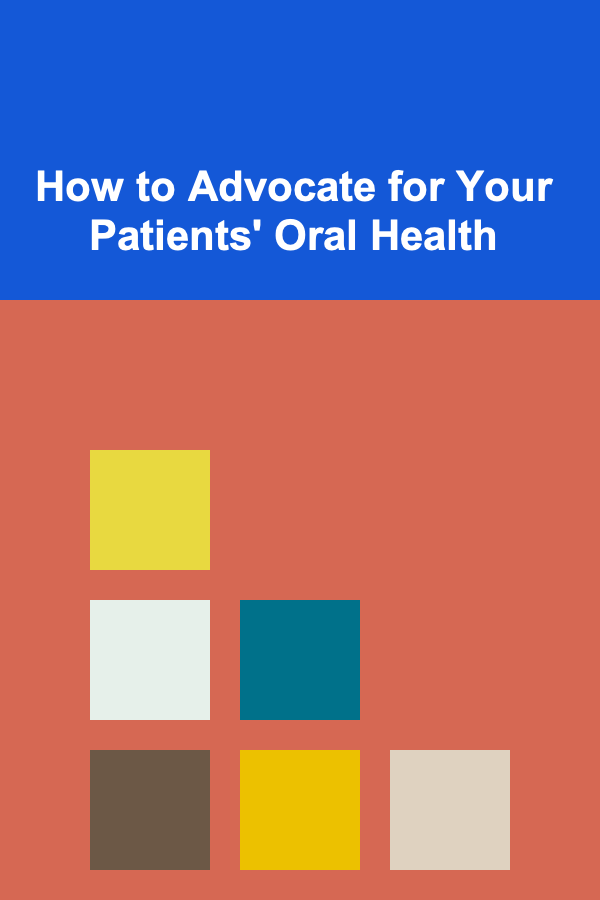
How to Advocate for Your Patients' Oral Health
ebook include PDF & Audio bundle (Micro Guide)
$12.99$7.99
Limited Time Offer! Order within the next:

Oral health is an essential part of overall health and well-being, yet it is often overlooked in the broader healthcare context. As a healthcare provider, whether you are a doctor, dentist, nurse, or allied health professional, advocating for your patients' oral health is not just a professional responsibility but also a moral imperative. This article delves into how you can effectively advocate for your patients' oral health, ensuring they receive the best care, guidance, and resources to maintain good oral hygiene.
Understanding the Connection Between Oral Health and General Health
The first step in advocating for oral health is understanding the critical connection between oral health and overall health. Oral health is a reflection of general health, and the mouth can often show signs of other health issues. Conditions like diabetes, heart disease, and even some cancers can manifest through oral symptoms such as gum disease, bad breath, or mouth ulcers. Furthermore, poor oral health can lead to serious conditions, such as:
- Gum Disease (Periodontitis): It is linked to heart disease, diabetes, and stroke.
- Tooth Decay: Affects more than 90% of the population and can lead to severe complications if untreated.
- Oral Cancer: Late diagnosis of oral cancer can severely reduce survival rates.
As an advocate for your patients' health, it's crucial to communicate the importance of oral hygiene in preventing these conditions.
Educating Patients on Oral Health
Education is one of the most powerful tools in advocating for your patients' oral health. Many patients might not fully understand the consequences of neglecting oral care or may believe that visiting a dentist is only necessary when they experience pain. Here's how you can educate them:
1. Promote Regular Dental Visits
Regular dental checkups are essential in catching problems early. Encourage your patients to see their dentist at least twice a year for a full checkup. Remind them that oral health is not just about fixing issues when they arise but about prevention and maintaining good oral hygiene.
2. Teach Proper Brushing and Flossing Techniques
Many people do not brush or floss properly, leading to plaque buildup, which can result in gum disease and tooth decay. Educating your patients on the correct brushing technique---gentle brushing with a fluoride toothpaste---and the importance of flossing can help prevent oral diseases.
3. Dietary Recommendations
Advocating for a balanced diet rich in nutrients that support oral health is crucial. Diets high in sugar, acidic foods, and sugary drinks increase the risk of cavities and gum disease. Encourage patients to reduce their sugar intake and include more teeth-friendly foods such as:
- Dairy products (rich in calcium)
- Vegetables and fruits (help produce saliva and neutralize acids)
- Whole grains (provide fiber and support overall health)
4. Fluoride Use
Fluoride is a natural mineral that helps protect against tooth decay. If your patients do not have access to fluoridated water or toothpaste, consider recommending fluoride supplements or professional treatments.
Encouraging Preventive Care
Prevention is better than treatment, and this saying holds particularly true in the context of oral health. As a healthcare professional, you can advocate for preventive measures by ensuring that your patients have access to:
1. Sealants
Dental sealants are thin, plastic coatings applied to the chewing surfaces of the back teeth, where cavities are most likely to develop. They are especially beneficial for children and adolescents but can also be used for adults who are at risk of cavities.
2. Mouthguards
For patients who participate in contact sports or who grind their teeth (bruxism), mouthguards can help prevent injuries to the teeth and reduce the risk of long-term damage. Advocate for custom-fitted mouthguards for athletes and teeth grinders.
3. Vaccination Against HPV
The human papillomavirus (HPV) is a major cause of oral cancer. Encouraging the HPV vaccination for both children and adults can help prevent certain types of oral cancer, especially in patients with a family history or other risk factors.
4. Tobacco Cessation
Tobacco use, including smoking and chewing tobacco, is a leading cause of oral cancer and gum disease. Advocate for tobacco cessation programs and provide patients with the tools and resources to quit. Discussing the impact of tobacco on oral health can also lead to broader conversations about quitting smoking, which can improve overall health.
Addressing Barriers to Oral Health Care
One of the key challenges in advocating for your patients' oral health is overcoming barriers to accessing dental care. These barriers may include:
- Lack of Insurance: Many people do not have dental insurance or cannot afford dental care out-of-pocket.
- Limited Access to Providers: Some communities may have a shortage of dentists, making it difficult for patients to get appointments.
- Health Literacy: Some patients may not fully understand the importance of oral health or how to care for their teeth.
As a healthcare provider, there are several ways you can help patients overcome these barriers:
1. Referral to Dental Resources
If a patient cannot afford dental care, refer them to community health centers or nonprofit organizations that offer free or low-cost dental services. Many areas also have dental schools where students provide care at a reduced cost under professional supervision.
2. Collaborating with Dentists
Building strong relationships with local dental professionals can help ensure that your patients are receiving comprehensive care. Refer patients to trusted dental providers, and communicate with them to ensure a smooth care transition.
3. Advocating for Dental Coverage
If your patient lacks insurance, advocate for policies that include dental coverage in health insurance plans. You can also inform patients about dental discount programs or government assistance programs for those who are eligible.
4. Promoting Health Literacy
Many patients are unaware of the importance of oral health or how it affects their overall well-being. Take the time to explain how oral health can influence heart health, diabetes, and other systemic diseases. Use visuals, simple language, and provide handouts or online resources to reinforce your points.
Addressing Special Populations
Certain groups of patients may require special consideration when it comes to oral health advocacy. These groups include children, the elderly, pregnant women, and patients with chronic conditions.
1. Children and Adolescents
Children's oral health sets the foundation for lifelong habits, so advocating for early dental care is crucial. Ensure that children see a dentist by age one and receive regular checkups thereafter. Teach parents the importance of oral hygiene from an early age, including the use of fluoride toothpaste and avoiding sugary snacks.
2. Pregnant Women
Pregnancy can affect oral health in various ways, including pregnancy gingivitis and an increased risk of tooth decay. Advise pregnant women on maintaining proper oral hygiene, getting routine dental checkups, and addressing any oral health concerns during pregnancy. Additionally, emphasize the importance of oral health for both the mother and the developing fetus, as maternal oral health can impact the baby's health.
3. Elderly Patients
The elderly are at higher risk for gum disease, tooth loss, dry mouth, and oral cancer. Encourage regular dental visits for older adults and advocate for proper care to prevent issues like denture-related problems or untreated decay. For patients with cognitive impairments like dementia, provide caregivers with oral hygiene instructions to ensure continued care.
4. Patients with Chronic Diseases
Patients with chronic conditions like diabetes, heart disease, or autoimmune disorders often face greater challenges in maintaining oral health. Educate these patients on the specific oral health risks associated with their conditions, and work collaboratively with other healthcare providers to ensure that their dental health is well-managed.
Incorporating Technology in Oral Health Advocacy
Technology is transforming the way we approach healthcare, including oral health. As an advocate for your patients' oral health, consider incorporating technology into your practice and communication:
1. Telehealth Consultations
For patients who are unable to visit the dentist or have limited access to dental care, telehealth consultations can offer a viable alternative. You can discuss oral health concerns, guide patients in proper hygiene techniques, and provide recommendations for local dental care providers.
2. Dental Apps
There are numerous dental apps available that help patients track their oral health. These apps can remind patients to brush and floss, provide educational materials, and even offer virtual consultations with dental professionals.
3. Digital Education Tools
Use digital platforms to educate patients about the importance of oral health. Share informative videos, infographics, and articles on your practice's website or social media channels. Digital tools can also be used for tracking progress, such as when patients successfully quit smoking or maintain a regular brushing schedule.
Conclusion
Advocating for your patients' oral health is a comprehensive and ongoing effort that requires education, collaboration, and resourcefulness. By educating your patients, addressing barriers to care, and utilizing modern tools and technologies, you can help your patients maintain good oral hygiene and prevent oral diseases. Your role as an advocate for oral health goes beyond the office or clinic---it's about fostering a culture of prevention and well-being that can lead to better health outcomes for your patients now and in the future.
Reading More From Our Other Websites
- [Personal Care Tips 101] How to Apply Hair Oil Before Styling
- [Personal Finance Management 101] How to Use Financial Apps to Simplify Money Management
- [Home Staging 101] How to Stage a Home with Neutral Tones to Appeal to More Buyers
- [Home Renovating 101] How to Achieve a Stunning Small Bathroom Remodel on a Tiny Budget
- [Home Budget Decorating 101] How to Achieve Frugal Home Styling: A Guide to Creating High-End Looks Without Breaking the Bank
- [Personal Care Tips 101] How to Choose Sunscreen That Works Well for Your Skin's Needs
- [Home Storage Solution 101] How to Store Seasonal Clothes Without Taking Up Space
- [Home Cleaning 101] How to Tidy Up Your Bedroom and Keep It Organized
- [Personal Investment 101] How to Invest in Cryptocurrency for the Long-Term
- [Home Holiday Decoration 101] How to Style Your Holiday Tree with Unique Ornaments

How to Create a System for Managing Digital Receipts
Read More
How to Start Investing with Minimal Risk
Read More
How To Understand the Role of Play in Learning
Read More
The Ultimate Guide to Achieving Glass Skin: A Comprehensive Approach
Read More
How To Create Effective Webinars for Your Small Business
Read More
10 Tips for a Thorough Home Buyer's Inspection Checklist
Read MoreOther Products

How to Create a System for Managing Digital Receipts
Read More
How to Start Investing with Minimal Risk
Read More
How To Understand the Role of Play in Learning
Read More
The Ultimate Guide to Achieving Glass Skin: A Comprehensive Approach
Read More
How To Create Effective Webinars for Your Small Business
Read More